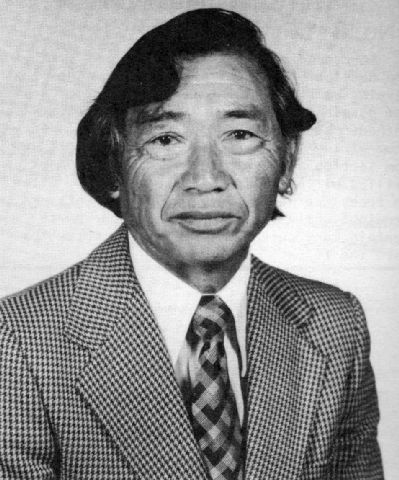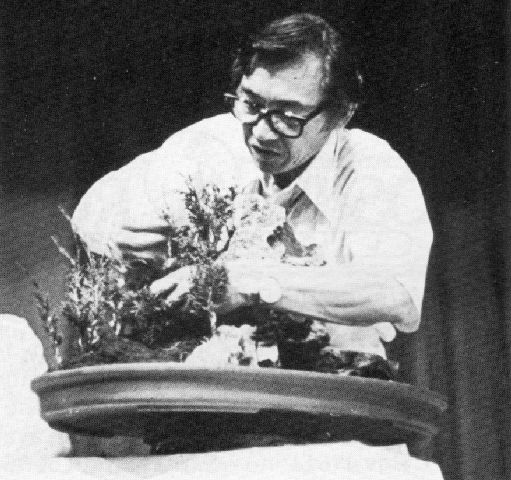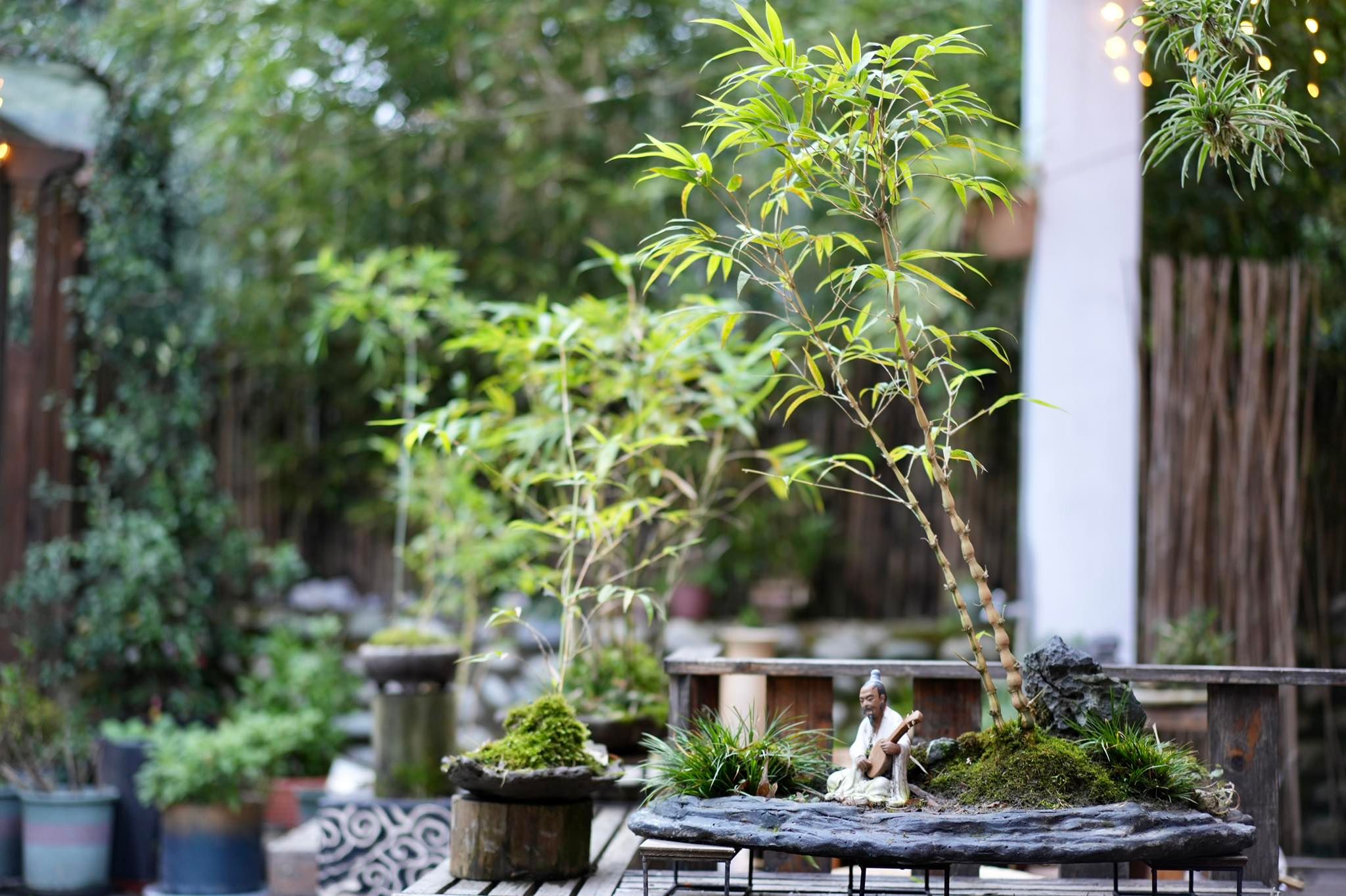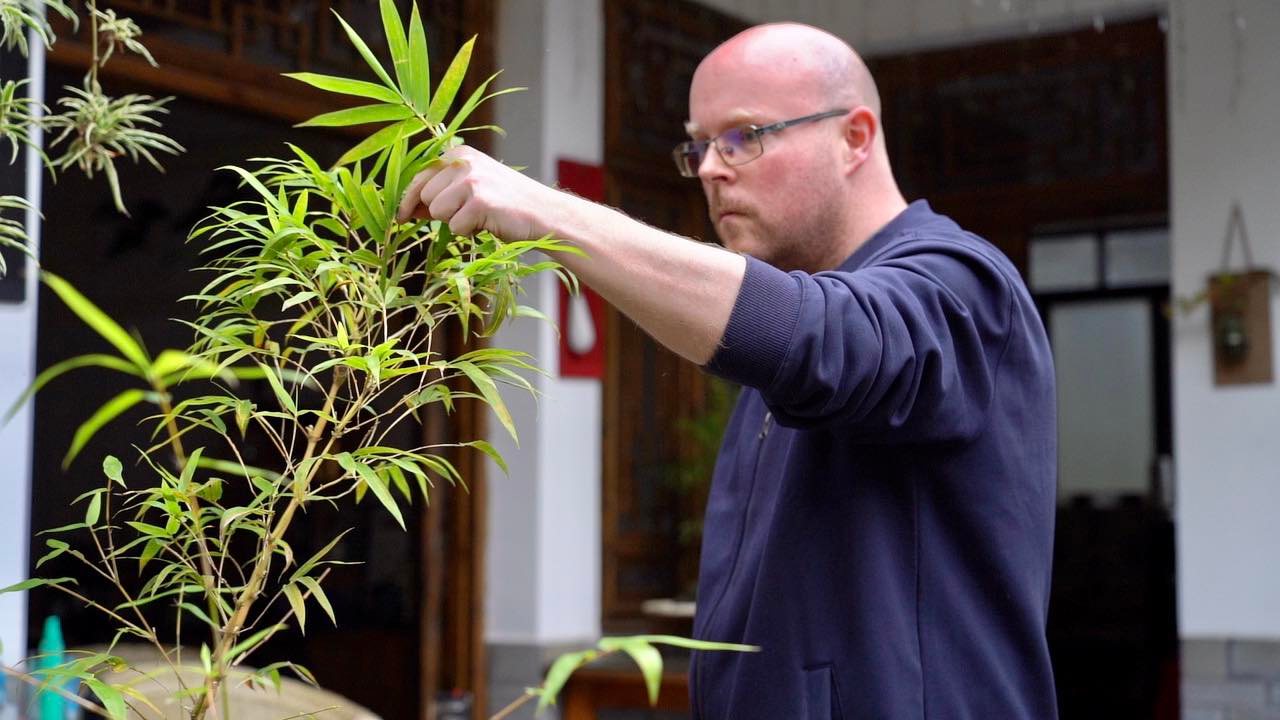| 11 |
|
||||
| 12 |
1996 -- The by-laws for a new association, Collegio Nazionale Istruttori del Bonsai e del Suiseki (IBS), were
ratified in Milan. The Italian National Association of Bonsai and Suiseki Instructors unites persons who
are qualified in teaching and spreading these disciplines. In addition to creating and updating a
professional registry of these instructors, IBS represents all recognized Instructors in Italy and abroad,
taking care of their training and updating programmes, taking care of research and documentation, and promoting
relations with other Italian and foreign Associations. One of the most representative pioneers of Italian
Bonsai, Prof. Giovanni Genotti, was the first chairman and would serve a three-year term.
("The History of IBS,"
http://www.collegioibs.it/new/chisiamo.htm)
2019 -- Long-time first generation Ohio bonsai nurseryman and teacher Anthony "Tony" Mihalic died. (Facebook post on April 12, 2019 by Frank Mihalic) SEE ALSO: Mar 23, Jun 4 |
||||
| 13 |
1937 -- Larz Anderson
died. [Six months later, thirty of his
bonsai would be gifted to Arnold Arboretum by Mrs. Isabel Anderson in memory
of both her late husband and the first director of Arnold, Charles Sargent.
Isabel would die in November 1948, and the following July the remaining nine
plants in the collection would be donated to the Aboretum.]
(Born on August 15, 1866, Anderson had graduated from Harvard College in 1888 and spent the next two years travelling the globe. He first visited Japan in 1889, bringing back two dwarf maples. He was then assigned to the U.S. Embassies in London and Rome throughout most of the 1890s and acted as an adjutant general in the 2nd Army Corps during the Spanish-American War. Appointed ambassador extraordinary and plenipotentiary to Japan in November 1912 by Republican President William H. Taft, Anderson resigned the following March with the change in administration (Democratic Pres. Woodrow Wilson). Among his various awards was the Grand Cordon, 1st Class, Order of the Rising Sun.) (After his post, Anderson bought at least forty trees from the Yokohama Nursery Company. These first significant bonsai in this country reached his home in Brookline, Massachusetts on March 6. These plants were accompanied by the first of a series of Japanese gardeners to care for them -- the most famous of them was Rainosuke Awano, who maintained the collection beginning in 1932 while studying for his doctorate in philosophy at Columbia University. The trees were put on public display on at least two occasions: at the 1916 spring flower show of the Massachusetts Horticultural Society, and again in November 1933 when the M.H.S. sponsored a show of chrysanthemums and bonsai.) 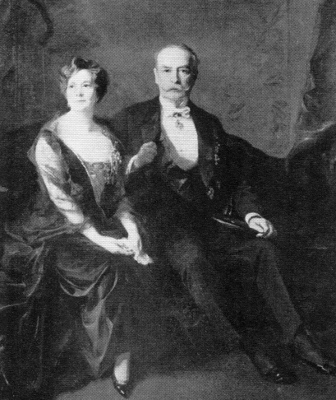
"Ambassador and Mrs. Larz Anderson. Portrait by
Philip de Laszlo.From Larz Anderson, Letters and Journals of a Diplomat, edited by Isabel Anderson, 1940." (Del Tredici, Peter "From Temple To Terrace," Arnoldia, Vol. 64, Numbers 2-3, 2006, pg. 17) 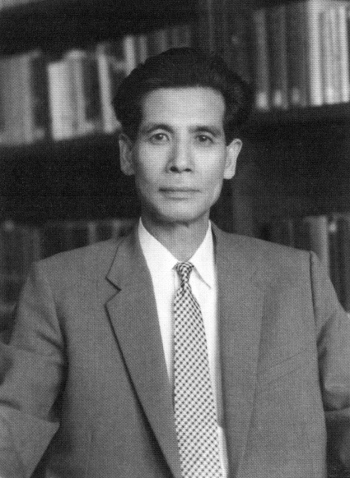
"Rainosuke Yori Awano in 1950. Photograph
courtesy of Ohio Wesleyan University." (Del Tredici, Peter "From Temple To Terrace," pg. 21) 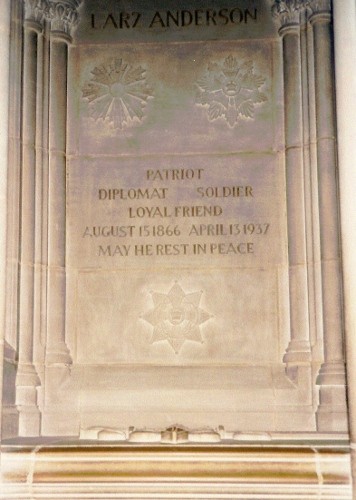
["Among them were trees given to [Anderson] by the Emperor. This collection was brought into the country before the bare root" laws and so had a better chance for survival than modern imports. Since then a few other trees have been added from various donations. The most impressive among the Larz Anderson bonsai are five very large Chamaecyparis obtusa nana which measure, from the bottom of the container to the top of the tree, from three to six feet! They are of the type which was used in the great halls of the palace. To my knowledge, the only other bonsai of this size are to be found in the Imperial collection in Japan. According to the Arboretum records, these trees vary from approximately 100 years in age to about 230. Another large tree, which has a nice trunk, is a white pine about 75 years old." A 2022 update on the collection can be seen here.] (Photograph of Anderson's burial niche taken during RJB's visit to the National Cathedral, Washington, D.C., July 1998. Ironically, this is the same place where only one U.S. President is encrypted also (though along a different wall): Woodrow Wilson; Who Was Who In America, Vol. 1, 1897-1942, (Chicago: Marquis-Who’s Who Incorporated, 1966), p. 23; “The Art of Bonsai” by Jean O'Connell, Science Digest, March 1970, pg. 38; “Perfect Proportions” by Bernie Ward, SKY Magazine, Delta Airlines, December 1992, pg. 32; Among them were trees quote from "Wintering Bonsai at the Arnold Arboretum" by Constance Derderian, Bonsai Journal, ABS, Vol. 3, No. 4, Winter 1970, pg. 112; Early American Bonsai: The Larz Anderson Collection of the Arnold Arboretum by Peter Del Tredici, (Jamaica, MA: Arnold Arboretum, Harvard University, 1989), pg. 6, which mentions that Anderson held his post in Japan for 6 months, and also pp. 9-12.) SEE ALSO: Feb 7, May 12, Sep 20; and this excerpt from Isabel's book, The Spell of Japan. |
||||
| 14 |
1977 -- The three-day First Annual Show of the Naungat Bonsai Society began in the National Guard Armory in
Anchorage, Alaska as part of the Anchorage Flower and Garden Show.
("Show Calendar," Bonsai Magazine, BCI, March 1977, Vol. XVI, No. 2, pg. 63)
2006 -- Hideo Marushima died. (He was Japan's leading authority on the history of both bonsai and suiseki. He wrote the chapter "The History of Bonsai" in the Nippon Bonsai Association's Classic Bonsai of Japan (1989), and was the author of many books on this subject including History of Japanese Stones (1992), Studies on the Historical Influences of Chinese Penjing on Japanese Bonsai (1998), and the three volume The World of Chinese Penjing (2000) co-authored with Hu Yunhua. Mr. Marushima was an attorney in Tokyo.) (Personal e-mail to RJB from Bill Valavanis, 20 Jun 2006; cover flap of Classic Bonsai of Japan (Tokyo and New York: Kodansha International, 1989)) 2006 -- Kiichi "Wayne" Takayasu, 82, of Santa Maria, CA passed away peacefully. He had been a founding a member of the Santa Maria Bonsai Club. He and his wife Hatsuko just celebrated their 60th wedding anniversary on March 20. Wayne also left behind their five children, a surviving brother, 3 remaining sisters, seven grandchildren, and two great grandchildren. ("Kiichi 'Wayne' Takayasu," http://santamariatimes.com/lifestyles/announcements/obituaries/obituaries/article_d308c10e-3908-52f5-acb6-0111b4765c2d.html) SEE ALSO: Feb 25 |
||||
| 15 |
1942 -- Hiroshi Takeyama was born. [At age twenty Hiroshi would apprentice to his
father and then, in 1979 when his father died, go on to own that Fuyo-en Bonsai Garden in Omiya. Hiroshi would
publish many books about bonsai and serve as a lecturer on the NHK-TV program "Hobby Bonsai." He would be
well-known as a "Zoki (deciduous tree) Bonsai" artist and be particularly good at Yose-ue (forest style). In
2003 he would become the third Director of the Nippon Bonsai Association. Additionally, he would serve as
Executive Director of the Nippon Bonsai Growers Cooperative and Managing Director of the Nippon Bonsai Growers
Association. See also this
Bonsai interview Hiroshi Takeyama - English subtitle.]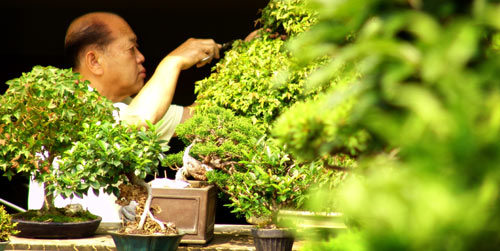
Hiroshi Takeyama, 07/12/05, by Morten Albek.
("Demonstrator -- Mr. Hiroshi Takeyama," Aug. 27, 2010, 11th
ASPAC; "Hiroshi Takeyama," 5th World Bonsai Convention Presenters,
http://web.archive.org/web/20040807211657/http://www.bonsai-wbff.org/wbc5/presenters/htakeyama.htm,
which gives his birth year as 1941.)
SEE ALSO: Jun 1
(Photo courtesy of Alan Walker, 05/11/07) |
||||
| 16 |
1996 -- Bonsai artist, teacher, and landscape gardener Toshio Saburomaru died at age 78 near
his home in Mountain View, California. (In 1955 he had helped organize the Kusamura Bonsai
Association at his Menlo Park nursery. Working with others who studied under Yuji Yoshimura when that
new-to-the-West teacher visited the Bay area, "Tosh" helped form an association of six area clubs whose first
newsletter was issued in November 1962. "Bonsai Clubs Association Newsletter" would be renamed Bonsai
Clubs International's Bonsai Magazine within six years and Tosh always gave that organization and
publication his full support. For many years his "Seasonal Reminders" was a regular feature. Tosh
taught and demonstrated at numerous conventions throughout the U.S, and was the first American bonsai artist to
teach in Latin America when he was invited to Venezuela in 1979. Beginning about 1973 he also began hosting
a regular series of tours to Japan, again exposing his students to the latest in the art of bonsai.)
|
||||
| 17 |
1917 -- Richard "Dick" Blake Shaner was born in London, England. (His family
would move to California when he was three. Years later, Dick and his wife Dixie would help found both the
Santa Anita Bonsai Society (1965) and the Golden State Bonsai Federation (1978), and they would be co-editors of
BCI's Bonsai Magazine from 1976-1982, with Dick being Executive Director of the Bonsai Clubs International.)
("Richard Blake Shaner,"
Find-A-Grave.com; "Bonsai Loses Good Friend," Bonsai Magazine, BCI, Vol. XXVIII, No. 2, March/April 1989,
pg. 33) SEE ALSO: Jan 1, Feb 25, Dec 22
1978 -- Chad Sinclair was born in Vancouver, Canada. His father was a well-known local bass player and singer who had issued two records, and his mother was an artist who loved painting, especially excelling at sketch, oil painting and water color. [Chad's grandmother was very fond of Chinese culture and would often take him to visit Chinatown. Her home was decorated in Chinese style, complete with a simulated Chinese penjing tree. His grandmother would take him to town on weekends to buy materials for her spacious garden ot to his aunts for afternoon tea on Sundays. afternoon. In the neighborhood was a Chinese Buddhist temple, which Chad would pass by every time they went shopping, The temple's traditional architecture would stand out among all the tall modern buildings. Finally, one afternoon when he'd be 9 years old, as they passed by, his grandmother would take him into the temple. Inside, there'd be a huge Chinese style garden with gurgling water, twittering birds and fragrant flowers. In addition, the courtyard would be decorated with many real Chinese penjing. Just like a seed planted in his heart, it would grow into a dream for him to study penjing in China. Chad would learn the basics of bonsai from Tak Yamaura, a long-time teacher in Surrey, British Columbia, Canada. While attending university, Chad would form a band with school fellows to prepare for his future musical ambitions. [His uncle would be a Christian singer and songwriter, and two of his cousins would have their own bands with fans all over the world. A few years after his father would have died in his late 40's, Chad would graduate and travel with friends to Europe and then Asia. He would end up by himself in China where he would observe the different kinds of natural landscapes and be captivated by the diversity of Chinese culture. In order to extend his stay in that country and learn more about this time-honored civilization, he would apply at an international school to teach English and art. For the first four years he would travel around many places, living in Bazhong in Sichuan (population around 300K), but travel during the holidays about 180 miles or 290 km to the southwest to Chengdu (then only with about 6.5MM people). Finally he would "meet" the Sichuan penjing, and this would be the magical miniature landscape style he'd want to pursue. As none of the local and talented penjing teachers spoke English at the time, Chad would wander around the various area parks and see beautiful penjing. He would stop to appreciate these compositions and study what he would do when making them. Over the years, he would often visit favorite penjing in the parks and admire how they'd be developing through time. After years of study he would gradually form his own "Sichuan Bonsai" style with about 80 compositions -- and cultivate friendships with many of the owners of nurseries in the area. He'd be encouraged to live and stay in China by his grandmother who'd remind him of his early dream. In his spare time he'd often visit bars to participate in rehearsals and give shows playing electric guitar at friends' parties. In order to devote more time to bonsai, he'd decide to leave the band he was part of. Little by little he'd devote more of his time to the creation and contemplation of miniature landscapes. Once while at a bookstore where foreigners in Chengdu would frequent the weekly jazz concerts, Chad would notice a woman next to him reciting words in English. After the show started, she'd pick up a guitar near the stage and perform a song. Singing and music drew him together with Li Junmei, from the town of Zigong (about 97 miles or 156 km south-southwest of Chengdu). After work he'd often walk her home. Instead of moving back to Canada, in August 2016 Bai Xiong ("White Bear," Chad's Chinese name) would marry this lady. Two years later in November at the invitation of the local government, Chad and his wife would come to the penjing village in Yanjiawanwan in western Chongzhou city. The first time the couple would visit the village they'd be immediately charmed by the beautiful landscape, safe atmosphere, and warm-hearted locals. Chad and Li would decide to set up their own penjing studio -- "White Bear Bonsai Garden" (in the suburbs of Chengdu, about 24 miles or 38 km west of the more international and now 8.8MM person city's center). They would design a garden with the plan to invite Chad's mother to visit there as soon as possible. Sadly though, his mother would pass away before the garden would be completed. [Before ariving at Yanjiawanwan, Chad would have never sold any of his bonsai trees because he loved each of his works. But from the first day he'd open his garden to the public, visitors would begin requesting to buy his creations. This would encourage him a lot because it would show that his works were appreciated by others. Down the road from their apartment, before the COVID 19 pandemic lockdowns, the couple would usually spend the weekends at the garden studio and put in an automatic watering system for their two hundred and fifty or so penjing. Li would help him get into penjing societies. Chad would prefer the relatively straightforward bamboo bonsai, reminiscent of the bamboo forest behind his grandmother's house in Vancouver. One of the reasons he would make bamboo penjing -- with each taking a couple of weeks to a month to properly make -- would be because he'd notice that their traditional creation in Sichuan was fading away. In 2020, he would be invited to exhibit his works at the 23rd Chengdu Bonsai Exhibition, becoming the first foreign artist to participate in this display. One of the compositions he would enter would win a silver medal, and the other a bronze. A long and low non-bamboo composition of his would make it into the 2021 China National Penjing Encyclopedia of CPAA (China Penjing Artist Association, section on Sichuan, pg. 216 -- his second year in the group). In 2021 and 2022 he'd sit for several video interviews, the foreigner who made traditional but living and developing pieces of the art of penjing. In March of 2022 Chad's permanent residence card would be given to him. It would open a lot of doors for him in China and knock down quite a few barriers for foreigners to deal with there. Three months later he would do an interview for Vision Sichuan magazine and in the summer would be included in two issues of that Chinese with English periodical. In early November 2022, a half dozen students from Chongzhou University would arrange to do their graduation video about Chad in his garden. He would establish a WeChat video account called Chad's Diary in which he'd explain how to create penjing. On social media he'd set up about 10 bonsai groups. By his own admission he'd describe his Chinese language ability as "horrible." He'd try his hand at making Chinese flower and bird paintings, calligraphy, and the tea ceremony. For additional relaxation he'd attempt to play the guqin, and collect Z gauge model trains. His wife would sing and also play keyboards and grow flowers. Li would also paint, make music, drink tea, spend quiet time, record videos, and travel with Chad. Upon return from various well-known tourist sites in the province during the holidays, he would be inspired by scenic views not seen in the books that he'd then want to create in the future. Chad would be invited to participate in the Chengdu Baihuatan 25th Penjing Exhibition to be held in 2024. As he'd be quoted in a local news report in early 2023, "At first I came to China just to learn bonsai, but Chinese culture is so rich and beautiful, I wanted to learn as much as I could, and I wanted to let the world know how cool Chinese culture is." In the future when his wife would retire from business meeting arrangement, he would like to open a penjing studio in Canada to build a bridge for cultural exchanges between Canada and China. Throughout 2024 he would sit for several print and video interviews. In the Spring, at the 2024 Chengdu World Horticulture and Horticulture Expo, Chad would be selected as the winner and become the "Expo Promotion Ambassador." A comprehensive video from near the end of the year is here on Facebook, and a year-end recap on Facebook is here.] 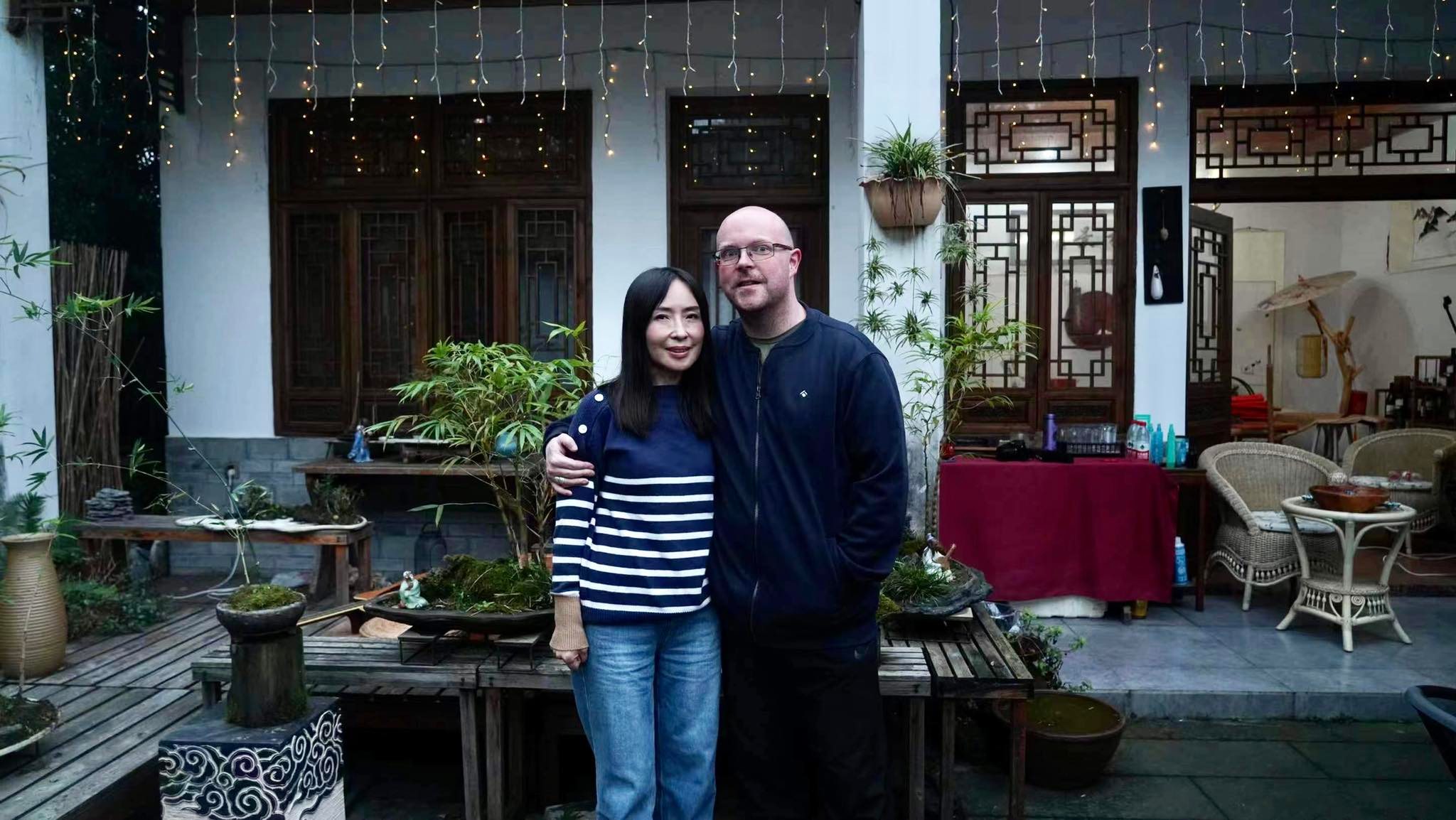
Li Junmei and Bai Xiong
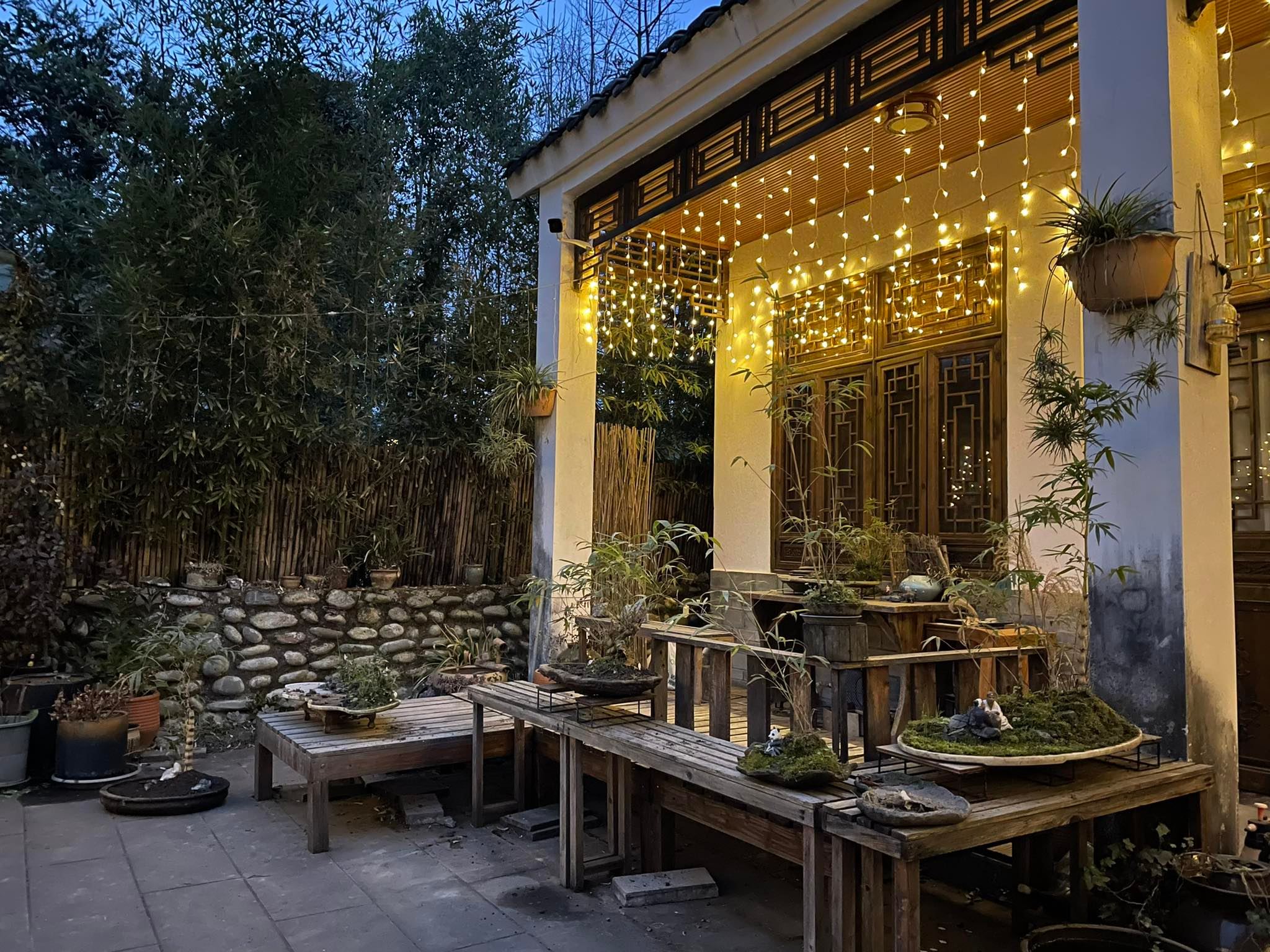
A Small Part of White Bear Bonsai Garden at Dusk
(various posts, responses and videos on Chad's Facebook page;
Yue Yitong, "Sichuan
Bonsai 'Foreign Fans' Chad: Ingenuity to Create 'Chinese and Western Beauty'," China News Network,
January 23, 2023; "Bai Xiong's Fantastic Penjing World: A Canadian in Sichuan," Vision Sichuan, August 2022, pp. 94-100;
"One Flower is a World, the Earthly Beauty in Sichuan-style Penjing," Vision Sichuan, July 2022, pp. 62-69;
Wang Wei, "A Canadian
Flavored Bonsai Garden," China Today, January 25, 2021; FB Messenger edits, additions and photos from
CS to RJB, 02/13/2023; Wang Mingfeng "I
hope to introduce Sichuan style bonsai to the world," People's Daily (China), June 12, 2024.)
|
||||
| 18 | 1996 -- "Potted Landscapes," a set of six postage stamps featuring penjing on flat marble bases atop carved wooden stands, was issued by the People's Republic of China (Mainland China). SEE ALSO: Jan 23, Jan 29, Feb 3, Feb 16, Mar 1, Mar 27, Mar 31, Apr 3, Apr 6, May 6, May 29, Jun 16, Jul 20, Aug 20, Aug 22, Sep 22, Oct 1, Oct 4, Dec 9. | ||||
| 19 |
1980 -- The First World Bonsai Convention was held in Osaka during the World Bonsai and Suiseki Exhibition (April
16-May 6) at the Expo '70 Commemoration Park. Representatives from ten countries attended the largest
exhibition ever staged up to that time: over eight hundred trees and stones from Japan and seventy-two photos of
bonsai (due to quarantine regulations) from fifteen other countries shown on fifty photographic panels.
At this convention, Saburō Katō convened a conference of bonsai leaders who unanimously adopted a
resolution to eventually establish an international bonsai association. [The World Bonsai Friendship
Federation would be organized nine years later in Omiya.]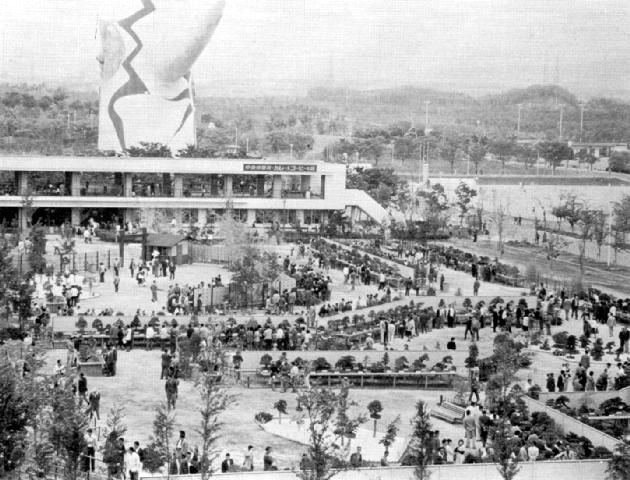
"Panoramic view of the entire exhibition site."
(International Bonsai, Summer/1980, pg. 29) SEE ALSO: Apr 6, Oct 15, Nov 3
(Photo by Nippon Bonsai Association) (International Bonsai, Winter 1980, pg. 24) 2003 -- Kenichi Oguchi of Okaya, Japan died at age 90. (He spent over 70 years collecting and growing bonsai and became known for his outstanding collection of shimpaku junipers, Ezo spruce and other conifers. He contributed the shimpaku juniper in the original 53 bonsai donated in 1976 in celebration of the U.S. Bicentennial. This tree became the signature tree and served as the model for the National Bonsai and Penjing Museum logo. Oguchi also developed a great interest in suiseki and assembled one of the largest collections of excellent suiseki in Japan. In 1987 his book illustrating his collection of bonsai and some stones was published. He also studied the art of calligraphy and became known throughout Japan for his fine brush works. In 2002, Oguchi donated to the U.S. National Arboretum three framed works of his calligraphy along with three suiseki. He was thus known as a master of the three most important elements for a successful tokonoma display.) ("Bonsai News -- Japan" submitted by Thomas S. Elias, Bonsai Magazine, BCI, July/August 2003, pp. 6-7) |
||||
| 20 |
1935 -- Lynn Ruth Perry was born in Youngstown, OH to Maude Orr Perry (née Millsop) and
Fred Thomas Perry Sr. [Lynn would be a girl scout, a cheerleader and a competitive swimmer and
sailor. She would sail her 19'
Lightning sailboat #653, the Jaylyn, all over
the eastern seaboard winning many races and a few silver trays. She would graduate with honors from Academy High
School, Erie, PA as a member of the National Honors Society in June 1953. Lynn would go on to the
Pennsylvania School of Horticulture for Women in Ambler,
graduating in 1957. She would also attend the
University of
Pennsylvania Graduate School of Landscape Architecture.] [Her greatest interest in the plant world would be bonsai. She would become the first American to study bonsai with a Japanese master for an extended period of time. For one or two days a week from 1960 through the fall of 1962, she would receive instruction from Kyuzo Murata at his nursery in Ōmiya, just north-northwest of Tokyo. After intensive practical and theoretical training, she would be awarded a teaching certificate by her sensei. During this time she would write and take photographs for Bonsai: Trees and Shrubs, A Guide to the Methods of Kyuzo Murata, which would be published in 1964 by The Ronald Press. While in Japan she would also serve as an assistant on the staff of the Agricultural Attaché at the American Embassy in Tokyo. (Perry would have been introduced by Kaname Kato to Kyuzo Murata. Kato, "a quiet Japanese gentleman, a scholar, and horticulturist," would also be the one who introduced Dr. John L. Creech to bonsai in 1955 during one of the latter's plant exploration travels to Asia. Creech, later as Director of the U.S. National Arboretum in Washington, D.C., would subsequently work to establish the National Bonsai Collection there, with Kato-san serving as an intermediary between Dr. Creech and the Japan Bonsai Society. Kato would also write the Foreword to Bonsai: Trees and Shrubs.) Lynn loved to travel, and would memorably sail through the Panama Canal en route home from Japan during the time of the Cuban Missile Crisis.] [Upon her return to the U.S., Lynn would first be employed by the landscape architect David H. Engel. (For several years in the 1950s, David would have studied in Japan under Tansai Sano, the late master landscape architect of Kyoto. Later in practice with an office in New York City, David would do both private residential and large scale commercial and public work. His designs would include the Japanese garden on the Rockefeller estate, acknowledged to be the finest in the Western world. A contributor to House Beautiful and The New Yorker, David would also author several books.) Lynn would assist as well with bonsai courses at the Brooklyn Botanic Garden. She then would become proprietor of Suzu-en Bonsai Company (a tool importer in Erie, Pa), lecturing, demonstrating and teaching throughout the country, especially in the East. A founding member of the Erie Bonsai Society, Lynn would be a tireless and conscientious student and grower of bonsai, nurturing some trees for forty-plus years. She would share this passion with her best friend, Jess Thompson, of Erie, herself a bonsai enthusiast. Seventeen members of the Bonsai Society of Greater New York would go to Japan in March 1967 for a week with Kyuzo Murata. The tour would take a year to plan and coordinate, with Lynn making arrangements. The group, including Lynn, Jerry Stowell, Marion Gyllenswan, George Hull, and Constance Derderian, would fly from San Francisco to Honolulu where they would meet with members of the local clubs there, and then on to Ōmiya, Japan. Upon the group's return to the States, several of the members would found the American Bonsai Society. Lynn would serve as a director for the ABS, be its membership secretary from 1969 through 1971, and co-edit with Dorothy S. Young A Manual For Appreciating, Judging, and Buying Bonsai for the ABS (1969, 1970, 1974). Lynn would do the narration for the ABS slideshow "Japanese Bonsai Collection, U.S. National Arboretum," prepared by Dorothy. Lynn would participate in the ABS Symposia in 1969, 1970, 1972 (joint with BCI), and 1980. February and March of 1969 would see the second ABS tour of Japan, led by Lynn and Jerry Stowell. After touring Takamatsu, Kyoto, and Nagoya, a five-day stay with Kyuzo Murata would further be highlighted by visits to the nine other prominent bonsai nurseries in Ōmiya and the opportunity to see the prestigious annual Kokufu-ten Bonsai Exhibition in Tokyo. Lynn would also lecture on "Pruning Pine Bonsai" at the International Bonsai Arboretum's 1983 Pine Bonsai Symposium.] [Lynn would marry Donald Martin Alstadt on December 26, 1967, and their only child, daughter Karen, would be born three years later.] Lynn would travel with Donald to Iran in 1975 as a guest of the Shah. Since 1980, Alstadt would run her family's business, the Dipwell Company. (Alstadt's mother would remain active in the business until her retirement in 2000.) Donald would retire as Chairman of the Board of the Lord Corporation of Erie, Pa in 1991. Lynn would move Dipwell to Northampton, Massachusetts in 2003, in order to be closer to her daughter, who would take over the business, and son-in-law Brian Baird Alstadt. Former husband Donald would die in February 2007 and Lynn would retire that year. As late as April of 2008, Lynn would lead a garden tour through Japan for the Carrie T. Watson Garden Club of Erie, Pennsylvania, of which she was a lifelong member.] 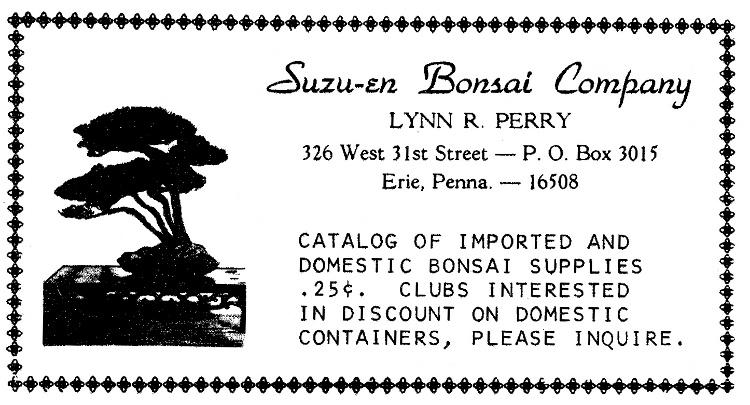
(Bonsai, BCI, October 1969, pg. 6)
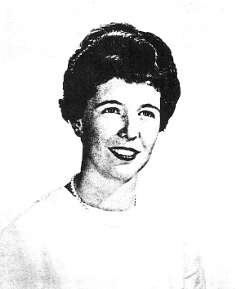
"Meet the Directors: Lynn Perry Alstadt"
(Bonsai Journal, ABS, Vol. 4, No. 4, Winter 1971, pg. 17)
Alan Walker, Kyuzo Murata, Lynn Perry and Dorothy Young at Murata's Ōmiya nursery, 04/07/89
(Personal e-mail to RJB from Karen Alstadt 2 Feb 2011; "Alstadt, Lynn Perry," 22 Jul 2008,
http://www.eriememorials.com/obituary/2008/07/07.22.08.html;
Perry, Lynn Bonsai, front biographical information; Bonsai Journal, ABS, Vol. 1, No. 1, Spring
1967, pp. 3-5, and Vol. 2, No. 2, pg. 19, and Vol. 11, No. 3, Fall 1977, pg. 70, and Vol. 21, No. 1, Spring 1987,
pg. 7; Young, Dorothy S. "History of Bonsai East," International Bonsai Digest presents Bonsai Gems
(Los Angeles: International Bonsai Digest, 1974), pp. 92; Young, Dorothy S. "The Catalyst," Bonsai Journal,
ABS, Vol. 8, No. 2, Summer 1974, pg. 40; "Maxson, Bob "Japan Visited," Bonsai Magazine, BCI, Vol. VII, No.
4, May 1968, pp. 10-11; "About the Author," A Japanese
Touch For Your Garden) SEE ALSO: Jan 25, Mar 1, Jun 9, Jul 20
(Today, only Walker is alive; Murata would die in 09/1991, Perry in 07/2008, and Young in 03/2001) (Photo courtesy of Alan Walker, 05/11/07) 1958 -- Hoping to make itself a state-wide organization, the Southern California Bonsai Society (changed from Club in 1953) was renamed the California Bonsai Society. [The group then presented its first annual exhibition of miniature trees at the California Museum of Science and Industry in Exposition Park in Los Angeles, running April 27 through May 4. The exhibit was judged a huge success and scheduled as an annual affair.] (BT by JYN, pg. 257; Komai's article, pp. 38-39; "Birds & Butterflies Space" by William J. McCann, Bonsai in California, Vol. 5, 1971, pg. 38; states that the shows started in 1957; "History of Bonsai West" by Dorothy S. Young, International Bonsai Digest presents Bonsai Gems, Fall 1974, pg. 94) 1988 -- The China Penjing Artists Association was formed. [The association would be run by a management committee and an executive committee. Professor Xu Xiaobai would work as chairman of the association. National Penjing Exhibitions with a total of 3,824 exhibits would be held five times since 1988. In 1991, an international penjing exhibition would be held in Beijing with 300 penjing lovers from Korea, Canada, America, Australia, Hong Kong and Taiwan. Nine Penjing Classes were also be presented, with more than 1,500 people going through the penjing course of training. There would be about 48 director members and 920 private members of the group over the nation by 2004.] ("The Organization and Activity of Penjing in China," by Prof. Su Xuehen, WBFF Director of China Region, World Bonsai Friendship Federation, http://www.bonsai-wbff.org/rchina.shtml, accessed 05/31/04.] 2011 -- Louis Nel was tragically killed while jogging. (At age 27, he was given a small bonsai as a gift in 1974. It very mysteriously died in his care within two weeks. His ego could not handle that, so the result was visits to the library, nurseries and generally making a nuisance of himself at flower and plant shows. Even the Department of Forestry and the Botany department at the University of Pretoria were not spared a visit or two by this seeker of knowledge on the subject of bonsai. Taking part in endurance events like the Comrades Marathon then taught him to "never give up." At last he came in contact with the Pretoria Bonsai Kai and was a member since 1975. (He trained as a pharmacist and made a living by being actively involved in two Pharmaceutical companies as well as a cosmetic manufacturing company.) While again training in the veld for the 1984 Comrades Marathon, Louis came across some Buddleja saligna trees, which he dug up and started training as bonsai. The trees responded very well and his interest in bonsai changed to a passion -- especially for Buddleja bonsai. One of his Buddlejas was selected as a top 100 tree in the Japanese Airlines competition of 2000 and another in 2003. Louis was an extremely talented and artistic bonsai enthusiast and always conducted his lectures, demonstrations and workshops in a most friendly and entertaining way. The brains of Václáv Novák, Marc Noelanders and Danny Use were unobtrusively picked during private discussions. Louis' expertise was recognised by John Naka as well as Roy Nagatoshi of the U.S., two great internationally-recognised masters. Once he even talked himself into and participated at a workshop by the Taiwanese master Cheng Kung Cheng during the Munich convention of 2001. Louis became better known to the International community through his various demonstrations at International Bonsai conventions and as the African representative of the World Bonsai Friendship Federation. An article of his about "Bonsai in South Africa" was published in the British and Dutch Bonsai Magazines and was also translated and published in the Czechoslovakian Bonsai Magazine. Another was published in the American Bonsai and Stone Appreciation Magazine. His "sometimes" quiet manner and personality was appreciated by all and many asked where his "Rebel without a Pause" motto came from. Once you got to know Louis, this became more evident. The art of bonsai had been that balance in his hyperactive and physical lifestyle. He loved the high mountains, empty African plains, deep valleys, long distances, big dogs and small trees. See also this tribute blog.) 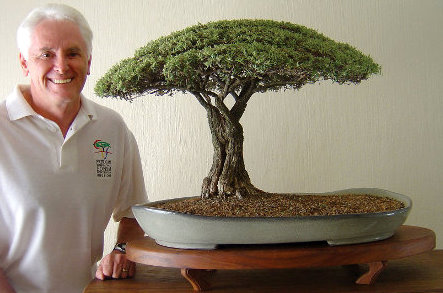
|
